iPhones are incredible devices, but even the most powerful models can slow down over time. Apps may take longer to load, and scrolling can become sluggish, turning simple tasks into frustrating experiences.
If your iPhone has gone from being a speedy sidekick to a sluggish snail, don’t worry! Here are some easy tips to get your device back in top shape.
1. Restart Your iPhone: The Digital Power Nap
It may seem simple, but when was the last time you turned off your device? Like us, iPhones need an occasional reboot. Restarting your phone clears temporary files, closes lingering apps, and frees up memory, providing a quick and easy refresh.
2. Clean Out the Digital Clutter
iPhones can become digital packrats, hoarding photos, videos, and apps we no longer use. This clutter can slow things down. Take some time to declutter your digital life.
- Photos and Videos: Review your library and delete blurry pics, duplicates, and anything you don’t need. Consider using cloud storage services like iCloud Photos or OneDrive to store memories without clogging your device’s storage space. Many services offer automated uploads for new pictures.
- Unused Apps: Identify apps you haven’t used in months and delete them to free up storage and reduce background activity.
- Offload Unused Apps (iOS 11 and later): This feature allows you to keep an app’s data while deleting the app itself, freeing up storage. When you need the app again, you can download it without losing any saved data.
- Remove Unneeded Podcasts: Many podcasts download to your device automatically. Review your iPhone’s storage and remove unnecessary podcast downloads.
3. Tame Background App Refresh
Background App Refresh lets apps fetch new content even when you’re not using them, which can drain your battery and slow down your phone. Review your settings and turn off Background App Refresh for apps that don’t need constant updates.
4. Limit Location Services
Many apps track your location even when you’re not using them, which can drain your battery and impact performance. Review your Location Services settings and restrict access for apps that don’t need constant location awareness.
5. Reduce Motion Effects
Apple’s motion effects, like app parallax and zoom animations, can be beautiful but resource-intensive. Turn off these effects to free up processing power and make your iPhone feel snappier.
6. Update Your Apps and iOS
App and iOS updates often include performance improvements and bug fixes. Ensure you’re running the latest versions of your apps and iOS for optimal performance and security.
7. Disable Automatic Downloads
Automatic updates for apps and iOS can sometimes occur at inconvenient times, slowing down your phone. Consider disabling automatic downloads and update manually when you have time and a good Wi-Fi connection. Make this a recurring task on your calendar, as updates are important for security.
8. Factory Reset: The Nuclear Option
If all else fails, a factory reset might be necessary. This wipes your iPhone clean and restores it to its original settings, clearing out bugs causing slowdowns. Before performing a factory reset, back up your iPhone and sign out of iCloud to avoid losing important data.
9. Check Your Battery Health
A degraded battery can contribute to slowdowns. Go to Settings > Battery > Battery Health to check your iPhone’s maximum battery capacity. If it’s below 80%, your phone might be throttling performance to conserve battery life. Consider replacing your battery for optimal performance.
By following these tips, you can diagnose the cause of your iPhone’s sluggishness and get it running smoothly again. A little maintenance goes a long way in keeping your iPhone happy and fast!
Need Help with a Smartphone or Tablet?
If your smartphone isn’t working right, don’t struggle alone. Get help from the pros. Our team can diagnose issues with smartphones, tablets, laptops, and other devices.
Contact us today to see how we can help!



